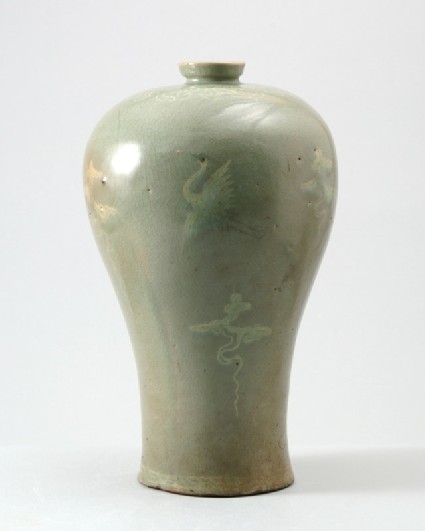The Barlow Collection
A select catalogue of the Barlow collection of Chinese Ceramics, Bronzes and Jades by the University of Sussex (published Sussex, 2006).

Publications online: 456 objects
Greenware maebyong, or plum blossom, vase with cranes
- loan
-
Literature notes
The vase has a wide bulging shoulder and tapers to a slender body, which widens again very slightly at the base, resting on a broad shallow footring. The narrow mouth has an everted angular rim. The shoulder is inlaid in white slip with a band of pendant overlapping ruyi-like petals, the body with three white cranes in flight, with beaks, crests and legs inlaid in contrasting black, surrounded by six white cloud motifs, with a white slanting key-fret border at the base. The light green glaze is crackled and has shrivelled on the base, and leaves the footring exposed in the brown-burnt biscuit. A long gilt repair is probably hiding a firing crack. -
Details
- Associated place
- Date
-
12th century (1101 - 1200)
Koryo Dynasty (AD 935 - 1392)
- Material and technique
- stoneware, thrown, with inlaid slip decoration under a green glaze; gold lacquer repair; unglazed base; glazed rim
- Dimensions
-
31.5 cm (height)
18.3 cm (diameter)
at base 11.7 cm (diameter)
- Material index
-
processed material › metal › gold,
- Technique index
- Object type index
- No. of items
- 1
- Credit line
- Lent by the Sir Alan Barlow Collection Trust.
- Accession no.
- LI1301.158
-
Further reading
University of Sussex, and Arts and Humanities Research Council, The Barlow Collection, supervised by Regina Krahl, Maurice Howard, and Aiden Leeves (Sussex: University of Sussex, 2006), no. C135
Glossary (4)
glaze, lacquer, slip, stoneware
-
glaze
Vitreous coating applied to the surface of a ceramic to make it impermeable or for decorative effect.
-
lacquer
Chinese and Japanese lacquer is made from the sap of the lacquer tree, which is indigenous to Eastern China. It is applied to wood as a varnish or for decorative effect. In India and the Middle East, lacquer is made from the deposit of the lac insect.
-
slip
A semi-fluid clay applied to a ceramic before glazing either to coat the surface or for decorative effect.
-
stoneware
Ceramic material made of clay which is fired to a temperature of c.1200-1300⁰c and is often buff or grey in colour.
Location
-
- currently in research collection
Objects are sometimes moved to a different location. Our object location data is usually updated on a monthly basis. Contact the Jameel Study Centre if you are planning to visit the museum to see a particular object on display, or would like to arrange an appointment to see an object in our reserve collections.
Publications online
-

The Barlow Collection
The vase has a wide bulging shoulder and tapers to a slender body, which widens again very slightly at the base, resting on a broad shallow footring. The narrow mouth has an everted angular rim. The shoulder is inlaid in white slip with a band of pendant overlapping ruyi-like petals, the body with three white cranes in flight, with beaks, crests and legs inlaid in contrasting black, surrounded by six white cloud motifs, with a white slanting key-fret border at the base. The light green glaze is crackled and has shrivelled on the base, and leaves the footring exposed in the brown-burnt biscuit. A long gilt repair is probably hiding a firing crack.
Notice
Object information may not accurately reflect the actual contents of the original publication, since our online objects contain current information held in our collections database. Click on 'buy this publication' to purchase printed versions of our online publications, where available, or contact the Jameel Study Centre to arrange access to books on our collections that are now out of print.
© 2013 University of Oxford - Ashmolean Museum





